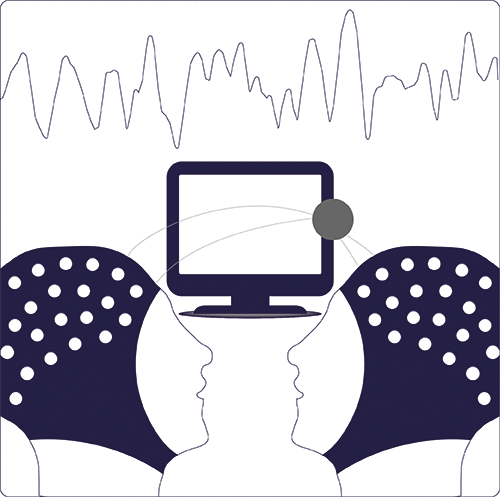Hyperscanning series part 1:
How to do hyperscanning with BrainAmps
by Dr. Alex Kreilinger
Strategic Product Manager (Brain Products)

This first part of the hyperscanning series introduces our current gold standard hardware solution for this application: the BrainAmps. Combining multiple BrainAmps allows using separate ground and reference channels for each participant and provides perfect clock synchronization in a single EEG recording file.
Hyperscanning refers to obtaining simultaneous recordings from more than one participant. It is useful for interactive and social studies and we have observed a growing interest in this topic in terms of support requests and publications in recent months and years. In this article we will focus mainly on how to record EEG, but we will also provide you with the necessary information on how to complete the setup by adding other physiological signals or signals coming from various sensors (for some examples please see our sensor tutorial).
One of the first questions that comes up when planning hyperscanning experiments is how to synchronize the EEG recorded from multiple participants. Another important question is whether there are any compromises in quality that must be considered in order to accommodate recording multiple participants at the same time.
Let’s start with some good news right away
If you choose the BrainAmp hardware-based hyperscanning solution, you don’t have to worry about either of those questions. Due to the modular design of our BrainAmps, it makes no difference whether you use more BrainAmps for an increased channel count or for combining multiple participants; the resulting EEG recording will always be perfectly synchronized. This synchronization is handled by the USB 2 Adapter, also known as BUA, where each individual BrainAmp is connected via fiberoptic cables. BrainAmps also have their separate ground and reference. This means that you do not have to think about doing some complicated re-referencing offline in order to access the individual signals. You can even look at EEG data from multiple participants online on the same recording computer, all while acquiring perfectly synchronized data, as all of the signals are collected by the BUA and passed on to BrainVision Recorder as one single data stream.
Furthermore, the BrainAmp setup also allows you to use one single trigger source. Triggers that arrive at the BUA are sampled with the EEG data, hence, assuring optimal synchronization. Simply plug your TriggerBox into the BUA and rest assured that your event markers appear exactly when and where they are supposed to.
Another advantage of the BrainAmp hyperscanning setup is that participants can be seated far apart thanks to the modular design and the very long fiberoptic cables (5 or 20 meters).
How many participants can I record?
As you might know, BrainAmps can be stacked up to a channel count of 256. If you want to tap the full potential of this setup, you can either go up to 8 participants using 32 channels each, or up to 4 participants with 64 channels each, or 2 with 128 channels each; otherwise, you can always go with lower numbers of participants and/or channels.
Please look at the schematic overview in Figure 1.
Figure 1 (click to open .pdf version): This figure demonstrates all the different options for hyperscanning with BrainAmps. Solid images indicate the minimum requirement, whereas transparent images show you optional additions, such as the ControlBox when using active electrodes. Note that PowerPacks can power up to two devices, but must not be shared between participants. The fiberoptic cables from all the BrainAmps need to be connected to the BUA corresponding to the participant sequence. An optional trigger source is connected to the BUA via the TriggerBox and all triggers and signals are synchronized and saved on one single recording computer in a single file.
Some tips
To optimize your hyperscanning experience and make subsequent analysis as smooth as possible, please also consider the following suggestions:
Figure 2 (click to open .pdf version): Hyperscanning setup for BrainAmp + ExG. For additional ExG and AUX channels, you will need an extra ExG AUX Box for every participant, connected to the corresponding BrainAmp ExG. These BrainAmp ExGs need to be connected to the BUAs last, after all the regular BrainAmps. Although this results in fewer potential EEG channels and participants, you can now add up to 8 bipolar ExG channels and up to 8 AUX channels per participant.
All articles of the hyperscanning series
References
[1] Zamm A., Debener S., Konvalinka I., Sebanz N., Knoblich G. (2020)
The sound of silence: an EEG study of how musicians time pauses in individual and joint music performance
Social Cognitive and Affective Neuroscience, Volume 16, Issue 1-2, January-February 2021, Pages 31–42.[2] Barraza, P., Pérez, A., & Rodríguez, E. (2020)
Brain-to-Brain Coupling in the Gamma-Band as a Marker of Shared Intentionality
Frontiers in Human Neuroscience, 14, 295



